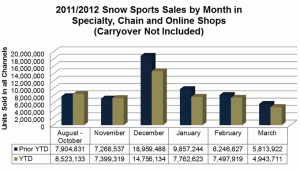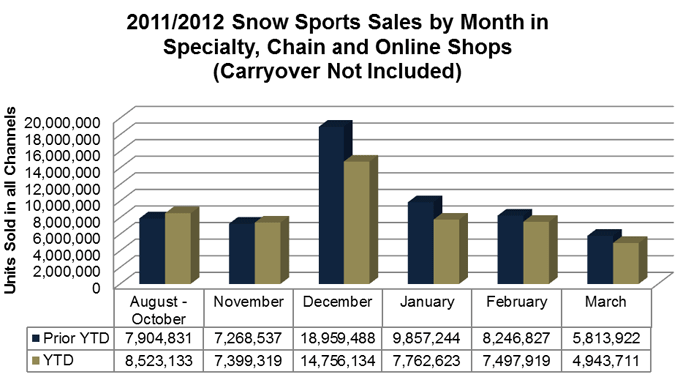McLean, VA – SnowSports Industries America (SIA) and The Leisure Trends Group have released the most recent ski and snowboard equipment and apparel retail sales numbers for March 2012, collected from the point of sale systems of more than 1,200 snow sports retailers across the U.S. The snow sports market brought in $3.4 billion during the 2011-12 season, $135 million less than last season thanks to a 12 percent decline in units sold.
This season started strong with plenty of momentum leftover from the record-breaking 2010-11 season and the promise of another epic winter of La Niña snow, but the repeat never materialized. In fact, the 2011-12 season may go down as one of the worst on record. December brought sparse snow across the country and the conditions didn’t improve until the third week of January. The lack of snow put a significant dent in sales and in snow sports participation; the National Ski Areas Association (NSAA) announced that skier/rider visits were down over 15 percent across U.S. snow sports resorts this season to 51 million skiers and snowboarders on the slopes. Resorts brought in fewer visitors and less revenue and visitors bought less equipment, apparel and accessories in the snow sports market.

Snow sports unit sales declined 12 percent overall this season, including a 17 percent decrease in units sold through chain stores and a 14 percent decrease in specialty shops. However, Internet sales did rather well, and increased 10 percent this year driven by late season equipment and accessories sales. This may indicate that many retailers are using commerce enabled websites to move product when in-shop sales have slowed. Excluding carryover, online unit sales increased 15 percent through February and March this season, compared to February and March 2010-11.
End of season inventory levels are having a significant impact on sell-in for next season. Retailers were not able to sell through the gear they purchased from suppliers this season, which drove up costs and reduced cash flow used to purchase product for the 2012-13 season. At season’s end there were 30 percent more units in specialty inventories overall. In fact, snow sports specialty retailers ended this season with 41 percent more equipment units, 46 percent more apparel units and 27 percent more accessories units sitting in inventory than at the end of the 2010-11 season. Suppliers are reporting significant declines in sell-in for next season as retailers struggled to move this season’s gear and manage the costs of carrying unexpected inventory that will surely result in lower margins and fewer profits until the snow begins falling in the 2012-13 season.

